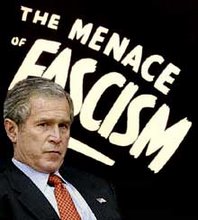More Bushlies for war
Explosive charge blows up in US's face
By Gareth Porter
WASHINGTON - When the United States military command accused the Iranian Quds Force in January of providing the armor-piercing EFPs (explosively formed penetrators) that were killing US troops, it knew that Iraqi machine shops had been producing their own EFPs for years, a review of the historical record of evidence on EFPs in Iraq shows.
The record also shows that the US command had considerable evidence that the Mahdi Army of Shi'ite cleric Muqtada al-Sadr had received the technology and the training on how to use it from Hezbollah, rather than Iran.
The command, operating under close White House supervision, chose to deny these facts in making the dramatic accusation that became the main rationale for the present aggressive US stance toward Iran. Although the George W Bush administration initially limited the accusation to the Quds Force, it has recently begun to assert that top officials of the Iranian regime are responsible for arms that are killing US troops.
British and US officials observed from the beginning that the EFPs being used in Iraq closely resembled the ones used by Hezbollah against Israeli forces in southern Lebanon, both in their design and the techniques for using them.
Hezbollah was known as the world's most knowledgeable specialists in EFP manufacture and use, having perfected this during the 1990s in the military struggle with Israeli forces in Lebanon. It was widely recognized that it was Hezbollah that had passed on the expertise to Hamas and other Palestinian militant groups after the second Intifada began in 2000.
US intelligence also knew that Hezbollah was conducting the training of Mahdi Army militants on EFPs. In August 2005, Newsday published a report from correspondent Mohammed Bazzi that Shi'ite fighters had begun in early 2005 to copy Hezbollah techniques for building the bombs, as well as for carrying out roadside ambushes, citing both Iraqi and Lebanese officials.
In late November 2006, a senior intelligence official told both CNN and the New York Times that Hezbollah troops had trained as many as 2,000 Mahdi Army fighters in Lebanon.
The fact that the Mahdi Army's major military connection has always been with Hezbollah rather than Iran would also explain the presence in Iraq of the PRG-29, a shoulder-fired anti-armor weapon. Although US military briefers identified it last February as being Iranian-made, the RPG-29 is not manufactured by Iran but by the Russian Federation.
According to the Israeli newspaper Ha'aretz, RPG-29s were imported from Russia by Syria, then passed on to Hezbollah, which used them with devastating effectiveness against Israeli forces in the 2006 war. According to a June 2004 report on the well-informed military website Strategypage.com, RPG-29s were already turning up in Iraq, "apparently smuggled across the Syrian border".
The earliest EFPs appearing in Iraq in 2004 were so professionally made that they were probably constructed by Hezbollah specialists, according to a detailed account by British expert Michael Knights in Jane's Intelligence Review last year.
By late 2005, however, the British command had already found clear evidence that the Iraqi Shi'ites themselves were manufacturing their own EFPs. British Army Major General J B Dutton told reporters in November 2005 that the bombs were of varying degrees of sophistication.
Some of the EFPs required a "reasonably sophisticated factory", he said, while others required only a simple workshop, which he observed, could only mean that some of them were being made inside Iraq.
After British convoys in Maysan province were attacked by a series of EFP bombings in late May 2006, Knights recounts, British forces discovered a factory making them in Majar al-Kabir north of Basra in June.
In addition, the US military also had its own forensic evidence by the autumn of 2006 that EFPs used against its vehicles had been manufactured in Iraq, according to Knights. He cites photographic evidence of EFP strikes on US armored vehicles that "typically shows a mixture of clean penetrations from fully-formed EFP and spattering ..." That pattern reflected the fact that the locally made EFPs were imperfect, some of them forming the required shape to penetrate but some of them failing to do so.
Then US troops began finding EFP factories. Journalist Andrew Cockburn reported in the Los Angeles Times in mid-February that US troops had raided a Baghdad machine shop in November 2006 and discovered "a pile of copper discs, five inches in diameter, stamped out as part of what was clearly an ongoing order".
In a report on February 23, NBC Baghdad correspondent Jane Arraf quoted "senior military officials" as saying that US forces had "been finding an increasing number of the advanced roadside bombs being not just assembled but manufactured in machine shops here".
Nevertheless, the Bush administration decided to put the blame for the EFPs squarely on the Quds Force of the Iranian Revolutionary Guard Corps, after Bush agreed in autumn 2006 to target the Quds Force within Iran to make Iranian leaders feel vulnerable to US power. The allegedly exclusive Iranian manufacture of EFPs was the administration's only argument for holding the Quds Force responsible for their use against US forces.
At the February 11 military briefing presenting the case for this claim, one of the US military officials declared, "The explosive charges used by Iranian agents in Iraq need a special manufacturing process, which is available only in Iran." The briefer insisted that there was no evidence that they were being made in Iraq.
That lynchpin of the administration's EFP narrative began to break down almost immediately, however. On February 23, NBC's Arraf confronted Lieutenant General Ray Odierno, who had been out in front in January promoting the new Iranian EFP line, with the information she had obtained from other senior military officials that an increasing number of machine shops manufacturing EFPs had been discovered by US troops.
Odierno began to walk the Iranian EFP story back. He said the EFPs had "started to come from Iran", but he admitted "some of the technologies" were "probably being constructed here".
The following day, US troops found yet another EFP factory near Baqubah, with copper discs that appeared to be made with a high degree of precision, but which could not be said with any certainty to have originated in Iran.
The explosive expert who claimed at the February briefing that EFPs could only be made in Iran was then made available to the New York Times to explain away the new find. Major Marty Weber now backed down from his earlier statement and admitted that there were "copy cat" EFPs being machined in Iraq that looked identical to those allegedly made in Iran to the untrained eye.
Weber insisted that such Iraqi-made EFPs had slight imperfections which made them "much less likely to pierce armor". But NBC's Arraf had reported the previous week that a senor military official had confirmed to her that the EFPs made in Iraqi shops were indeed quite able to penetrate US armor. The impact of those weapons "isn't as clean", the official said, but they are "almost as effective" as the best-made EFPs.
The idea that only Iranian EFPs penetrate armor would be a surprise to Israeli intelligence, which has reported that EFPs manufactured by Hamas guerrillas in their own machine shops during 2006 had penetrated eight inches of Israeli steel armor in four separate incidents in September and November, according to the Intelligence and Terrorism Center in Tel Aviv.
The Arraf story was ignored by the news media, and the Bush administration has continued to assert the Iranian EFP charge as though it had never been questioned.
It soon became such an accepted part of the media narrative on Iran and Iraq that the only issue about which reporters bother to ask questions is whether the top leaders of the Iranian government have approved the alleged Quds Force operation.
Gareth Porter is an historian and national security policy analyst. His latest book, Perils of Dominance: Imbalance of Power and the Road to War in Vietnam, was published in June 2005.
(Inter Press Service)
(In accordance with Title 17 U.S.C. Section 107, this material is distributed without profit to those who have expressed a prior interest in receiving the included information for research and educational purposes. I.U. has no affiliation whatsoever with the originator of this article nor is I.U endorsed or sponsored by the originator.)
The Nazis, Fascists and Communists were political parties before they became enemies of liberty and mass murderers.
Subscribe to:
Post Comments (Atom)




No comments:
Post a Comment